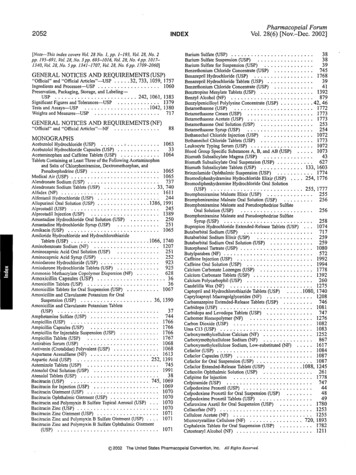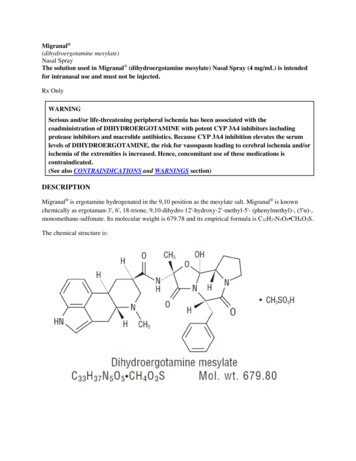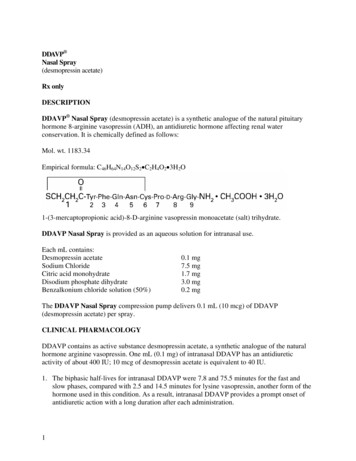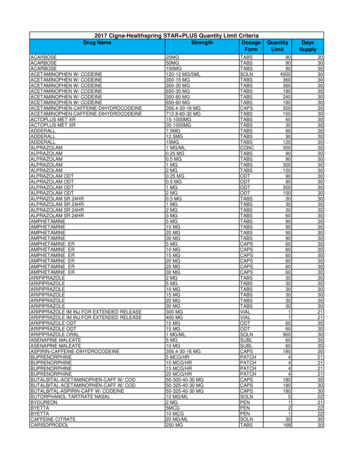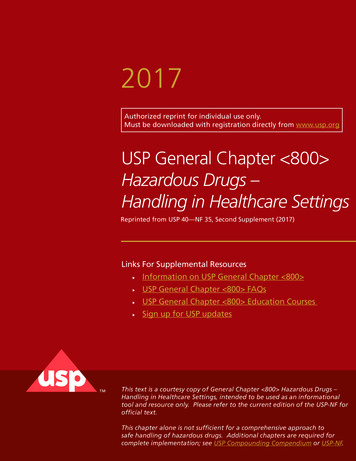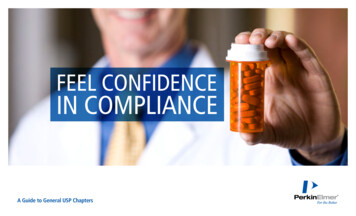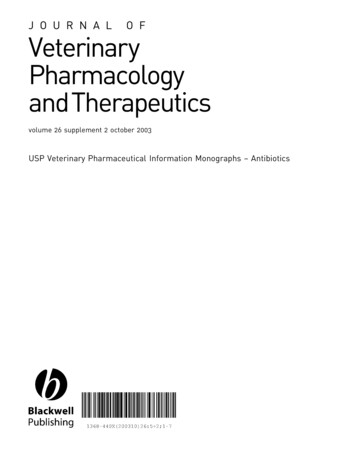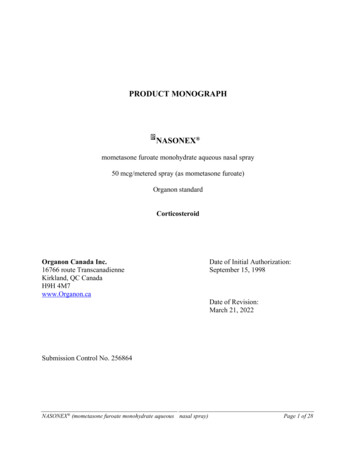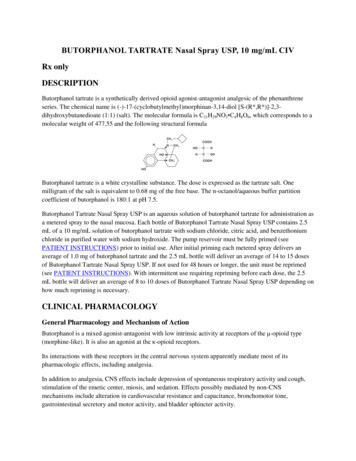
Transcription
BUTORPHANOL TARTRATE Nasal Spray USP, 10 mg/mL CIVRx onlyDESCRIPTIONButorphanol tartrate is a synthetically derived opioid agonist-antagonist analgesic of the phenanthreneseries. The chemical name is (-)-17-(cyclobutylmethyl)morphinan-3,14-diol [S-(R*,R*)]-2,3dihydroxybutanedioate (1:1) (salt). The molecular formula is C21H29NO2 C4H6O6, which corresponds to amolecular weight of 477.55 and the following structural formulaButorphanol tartrate is a white crystalline substance. The dose is expressed as the tartrate salt. Onemilligram of the salt is equivalent to 0.68 mg of the free base. The n-octanol/aqueous buffer partitioncoefficient of butorphanol is 180:1 at pH 7.5.Butorphanol Tartrate Nasal Spray USP is an aqueous solution of butorphanol tartrate for administration asa metered spray to the nasal mucosa. Each bottle of Butorphanol Tartrate Nasal Spray USP contains 2.5mL of a 10 mg/mL solution of butorphanol tartrate with sodium chloride, citric acid, and benzethoniumchloride in purified water with sodium hydroxide. The pump reservoir must be fully primed (seePATIENT INSTRUCTIONS) prior to initial use. After initial priming each metered spray delivers anaverage of 1.0 mg of butorphanol tartrate and the 2.5 mL bottle will deliver an average of 14 to 15 dosesof Butorphanol Tartrate Nasal Spray USP. If not used for 48 hours or longer, the unit must be reprimed(see PATIENT INSTRUCTIONS). With intermittent use requiring repriming before each dose, the 2.5mL bottle will deliver an average of 8 to 10 doses of Butorphanol Tartrate Nasal Spray USP depending onhow much repriming is necessary.CLINICAL PHARMACOLOGYGeneral Pharmacology and Mechanism of ActionButorphanol is a mixed agonist-antagonist with low intrinsic activity at receptors of the μ-opioid type(morphine-like). It is also an agonist at the κ-opioid receptors.Its interactions with these receptors in the central nervous system apparently mediate most of itspharmacologic effects, including analgesia.In addition to analgesia, CNS effects include depression of spontaneous respiratory activity and cough,stimulation of the emetic center, miosis, and sedation. Effects possibly mediated by non-CNSmechanisms include alteration in cardiovascular resistance and capacitance, bronchomotor tone,gastrointestinal secretory and motor activity, and bladder sphincter activity.
In an animal model, the dose of butorphanol tartrate required to antagonize morphine analgesia by 50%was similar to that for nalorphine, less than that for pentazocine and more than that for naloxone.The pharmacological activity of butorphanol metabolites has not been studied in humans; in animalstudies, butorphanol metabolites have demonstrated some analgesic activity.In human studies of butorphanol (see Clinical Trials), sedation is commonly noted at doses of 0.5 mg ormore. Narcosis is produced by 10 to 12 mg doses of butorphanol administered over 10 to 15 minutesintravenously.Butorphanol, like other mixed agonist-antagonists with a high affinity for the κ-receptor, may produceunpleasant psychotomimetic effects in some individuals.Nausea and/or vomiting may be produced by doses of 1 mg or more administered by any route.In human studies involving individuals without significant respiratory dysfuction, 2 mg of butorphanol IVand 10 mg of morphine sulfate IV depressed respiration to a comparable degree. At higher doses, themagnitude of respiratory depression with butorphanol is not appreciably increased; however, the durationof respiratory depression is longer. Respiratory depression noted after administration of butorphanol tohumans by any route is reversed by treatment with naloxone, a specific opioid antagonist (see Treatmentin OVERDOSAGE section).Butorphanol tartrate demonstrates antitussive effects in animals at doses less than those required foranalgesia.Hemodynamic changes noted during cardiac catheterization in patients receiving single 0.025 mg/kgintravenous doses of butorphanol have included increases in pulmonary artery pressure, wedge pressureand vascular resistance, increases in left ventricular end diastolic pressure, and in systemic arterialpressure.PharmacodynamicsThe analgesic effect of butorphanol is influenced by the route of administration. Onset of analgesia iswithin a few minutes for intravenous administration, within 15 minutes for intramuscular injection, andwithin 15 minutes for the nasal spray doses.Peak analgesic activity occurs within 30 to 60 minutes following intravenous and intramuscularadministration and within 1 to 2 hours following the nasal spray administration.The duration of analgesia varies depending on the pain model as well as the route of administration, but isgenerally 3 to 4 hours with IM and IV doses as defined by the time 50% of patients requiredremedication. In postoperative studies, the duration of analgesia with IV or IM butorphanol was similar tomorphine, meperidine, and pentazocine when administered in the same fashion at equipotent doses (seeClinical Trials). Compared to the injectable form and other drugs in this class, butorphanol tartrate nasalspray has a longer duration of action (4 to 5 hours) (see Clinical Trials).
PharmacokineticsButorphanol tartrate injection is rapidly absorbed after IM injection and peak plasma levels are reached in20 to 40 minutes.After nasal administration, mean peak blood levels of 0.9 to 1.04 ng/mL occur at 30 to 60 minutes after a1 mg dose (see Table 1). The absolute bioavailability of butorphanol tartrate nasal spray is 60 to 70% andis unchanged in patients with allergic rhinitis. In patients using a nasal vasoconstrictor (oxymetazoline)the fraction of the dose absorbed was unchanged, but the rate of absorption was slowed. The peak plasmaconcentrations were approximately half those achieved in the absence of the vasoconstrictor.Following its initial absorption/distribution phase, the single dose pharmacokinetics of butorphanol by theintravenous, intramuscular, and nasal routes of administration are similar (see Figure 1).Figure 1: Butorphanol Plasma Levels After IV, IM and Nasal Spray Administration of 2 mg DoseSerum protein binding is independent of concentration over the range achieved in clinical practice (up to7 ng/mL) with a bound fraction of approximately 80%.The volume of distribution of butorphanol varies from 305 to 901 liters and total body clearance from 52to 154 liters/hr (see Table 1).Table 1: Mean Pharmacokinetic Parameters of Butorphanol in Young and Elderly Subjects1IntravenousParametersTmax2 (hr)NasalYoungElderly7.24 (1.57)(4.40-9.77)4.56 (1.67)(2.06-8.70)8.71 (2.02)(4.76-13.03)5.61 (1.36)(3.25-8.79)487 (155)552 (124)Cmax5 (ng/mL)AUC (inf)6(hr ng/mL)Half-life (hr)AbsoluteBioavailability (%)Volume ofYoung0.62 (0.32)3(0.15-1.50)41.04 (0.40)(0.35-1.97)4.93 (1.24)(2.16-7.27)4.74 (1.57)(2.89-8.79)69 (16)(44-113)Elderly1.03 (0.74)(0.25-3.00)0.90 (0.57)(0.10-2.68)5.24 (2.27)(0.30-10.34)6.56 (1.51)(3.75-9.17)61 (25)(3-121)
Distribution7 (L)Total Body Clearance(L/hr)1.2.3.4.5.6.7.(305-901)99 (23)(70-154)(305-737)82 (21)(52-143)Young subjects (n 24) are from 20 to 40 years old and elderly (n 24) are greater than 65 years of age.Time to peak plasma concentration.Mean (1 S.D.)(range of observed values)Peak plasma concentration normalized to 1 mg dose.Area under the plasma concentration-time curve after a 1 mg dose.Derived from IV data.Dose proportionality for butorphanol tartrate nasal spray has been determined at steady state in doses upto 4 mg at 6 hour intervals. Steady state is achieved within 2 days. The mean peak plasma concentrationat steady state was 1.8-fold (maximal 3-fold) following a single dose.The drug is transported across the blood brain and placental barriers and into human milk (seePRECAUTIONS: Labor and Delivery and Nursing Mothers sections).Butorphanol is extensively metabolized in the liver. Metabolism is qualitatively and quantitatively similarfollowing intravenous, intramuscular, or nasal administration. Oral bioavailability is only 5 to 17%because of extensive first pass metabolism of butorphanol.The major metabolite of butorphanol is hydroxybutorphanol, while norbutorphanol is produced in smallamounts. Both have been detected in plasma following administration of butorphanol, withnorbutorphanol present at trace levels at most time points. The elimination half-life ofhydroxybutorphanol is about 18 hours and, as a consequence, considerable accumulation ( 5-fold) occurswhen butorphanol is dosed to steady state (1 mg transnasally q6h for 5 days).Elimination occurs by urine and fecal excretion. When 3H labelled butorphanol is administered to normalsubjects, most (70 to 80%) of the dose is recovered in the urine, while approximately 15% is recovered inthe feces.About 5% of the dose is recovered in the urine as butorphanol. Forty-nine percent is eliminated in theurine as hydroxybutorphanol. Less than 5% is excreted in the urine as norbutorphanol.Butorphanol pharmacokinetics in the elderly differ from younger patients (see Table 1). The meanabsolute bioavailability of butorphanol tartrate nasal spray in elderly women (48%) was less than that inelderly men (75%), young men (68%), or young women (70%). Elimination half-life is increased in theelderly (6.6 hours as opposed to 4.7 hours in younger subjects).In renally impaired patients with creatinine clearances 30 mL/min, the elimination half-life wasapproximately doubled and the total body clearance was approximately one half (10.5 hours [clearance150 L/h] as compared to 5.8 hours [clearance 260 L/h] in healthy subjects). No effect on Cmax or Tmax wasobserved after a single dose.After intravenous administration to patients with hepatic impairment, the elimination half-life ofbutorphanol was approximately tripled and total body clearance was approximately one half (half-life16.8 hours, clearance 92 L/h) compared to healthy subjects (half-life 4.8 hours, clearance 175 L/h). The
exposure of hepatically impaired patients to butorphanol was significantly greater (about 2-fold) than thatin healthy subjects. Similar results were seen after nasal administration. No effect on Cmax or Tmax wasobserved after a single intranasal dose.For further recommendations refer to PRECAUTIONS: Hepatic and Renal Disease, Drug Interactions,and Geriatric Use sections and to the CLINICAL PHARMACOLOGY: Individualization of Dosagesection below.Clinical TrialsThe effectiveness of opioid analgesics varies in different pain syndromes.Studies with butorphanol tartrate nasal spray have been performed in postoperative (general, orthopedic,oral, cesarean section) pain, in postepisiotomy pain, in pain of musculoskeletal origin, and in migraineheadache pain (see below).Use in the Management of PainPostoperative PainThe analgesic efficacy of butorphanol tartrate nasal spray was evaluated (approximately 35 patients pertreatment group) in a general and orthopedic surgery trial. Single doses of butorphanol tartrate nasal spray(1 or 2 mg) and IM meperidine (37.5 or 75 mg) were compared. Analgesia provided by 1 and 2 mg dosesof butorphanol tartrate nasal spray was similar to 37.5 and 75 mg meperidine, respectively, with onset ofanalgesia within 15 minutes and peak analgesic effect within 1 hour. The median duration of pain reliefwas 2.5 hours with 1 mg butorphanol tartrate nasal spray, 3.5 hours with 2 mg butorphanol tartrate nasalspray and 3.3 hours with either dose of meperidine.In a postcesarean section trial, butorphanol tartrate nasal spray administered to 35 patients as two 1 mgdoses 60 minutes apart was compared with a single 2 mg dose of butorphanol tartrate nasal spray or asingle 2 mg IV dose of butorphanol tartrate injection (37 patients each). Onset of analgesia was within 15minutes for all butorphanol tartrate regimens. Peak analgesic effects of 2 mg intravenous butorphanoltartrate injection and butorphanol tartrate nasal spray were similar in magnitude. The duration of painrelief provided by both 2 mg butorphanol tartrate nasal spray regimens was approximately 4.5 hours andwas greater than intravenous butorphanol tartrate injection (2.6 hours).Migraine Headache PainThe analgesic efficacy of two 1 mg doses 1 hour apart of butorphanol tartrate nasal spray in migraineheadache pain was compared with a single dose of 10 mg IM methadone (31 and 32 patients,respectively). Significant onset of analgesia occurred within 15 minutes for both butorphanol tartratenasal spray and IM methadone. Peak analgesic effect occurred at 2 hours for butorphanol tartratenasalspray and 1.5 hours for methadone. The median duration of pain relief was 6 hours with butorphanoltartrate nasal spray and 4 hours with methadone as judged by the time when approximately half of thepatients remedicated.In two other trials in patients with migraine headache pain, a 2 mg initial dose of butorphanol tartratenasal spray followed by an additional 1 mg dose 1 hour later (76 patients) was compared with either 75
mg IM meperidine (24 patients) or placebo (72 patients). Onset, peak activity and duration were similarwith both active treatments; however, the incidence of adverse experiences (nausea, vomiting, dizziness)was higher in these two trials with the 2 mg initial dose of butorphanol tartrate nasal spray than in the trialwith the 1 mg initial dose.Individualization of DosageUse of butorphanol in geriatric patients, patients with renal impairment, patients with hepatic impairment,and during labor requires extra caution (see below and the appropriate sections in PRECAUTIONS).The usual recommended dose for initial nasal administration is 1 mg (1 spray in one nostril). If adequatepain relief is not achieved within 60 to 90 minutes, an additional 1 mg dose may be given.The initial dose sequence outlined above may be repeated in 3 to 4 hours as required after the second doseof the sequence.For the management of severe pain, an initial dose of 2 mg (1 spray in each nostril) may be used inpatients who will be able to remain recumbent in the event drowsiness or dizziness occurs. In suchpatients additional doses should not be given for 3 to 4 hours. The incidence of adverse events is higherwith an initial 2 mg dose (see Clinical Trials).The initial dose sequence in elderly patients and patients with renal or hepatic impairment should belimited to 1 mg followed, if needed, by 1 mg in 90 to 120 minutes. The repeat dose sequence in thesepatients should be determined by the patient’s response rather than at fixed times but will generally be noless than at 6 hour intervals (see PRECAUTIONS).INDICATIONS AND USAGEButorphanol Tartrate Nasal Spray USP is indicated for the management of pain when the use of an opioidanalgesic is appropriate.CONTRAINDICATIONSButorphanol Tartrate Nasal Spray USP is contraindicated in patients hypersensitive to butorphanol tartrateor the preservative benzethonium chloride.WARNINGSPatients Dependent on NarcoticsBecause of its opioid antagonist properties, butorphanol is not recommended for use in patients dependenton narcotics. Such patients should have an adequate period of withdrawal from opioid drugs prior tobeginning butorphanol therapy. In patients taking opioid analgesics chronically, butorphanol hasprecipitated withdrawal symptoms such as anxiety, agitation, mood changes, hallucinations, dysphoria,weakness and diarrhea.
Because of the difficulty in assessing opioid tolerance in patients who have recently received repeateddoses of narcotic analgesic medication, caution should be used in the administration of butorphanol tosuch patients.Drug Abuse and DependenceDrug AbuseButorphanole tartrate, by all routes of administration, has been associated with episodes of abuse. Of thecases received, there were more reports of abuse with the nasal spray formulation than with the injectableformulation.Physical Dependence, Tolerance, and WithdrawalProlonged, continuous use of butorphanol tartrate may result in physical dependence or tolerance (adecrease in response to a given dose). Abrupt cessation of use by patients with physical dependence mayresult in symptoms of withdrawal.NoteProper patient selection, dose and prescribing limitations, appropriate directions for use, and frequentmonitoring are important to minimize the risk of abuse and physical dependence. (See DRUG ABUSEAND DEPENDENCE section below.)PRECAUTIONSGeneralHypotension associated with syncope during the first hour of dosing with butorphanol tartrate nasal sprayhas been reported rarely, particularly in patients with past history of similar reactions to opioid analgesics.Therefore, patients should be advised to avoid activities with potential risks.Head Injury and Increased Intracranial PressureAs with other opioids, the use of butorphanol in patients with head injury may be associated with carbondioxide retention and secondary elevation of cerebrospinal fluid pressure, drug-induced miosis, andalterations in mental state that would obscure the interpretation of the clinical course of patients with headinjuries. In such patients, butorphanol should be used only if the benefits of use outweigh the potentialrisks.Head Injury and Intracranial PressureAs with other opioids, the use of butorphanol in patients with head injury may be associated with carbondioxide retention and secondary elevation of cerebrospinal fluid pressure, drug-induced miosis, andalterations in mental state that would obscure the interpretation of the clinical course of patients with headinjuries. In such patients, butorphanol should be used only if the benefits of use outweigh the potentialrisks.
Disorders of Respiratory Function or ControlButorphanol may produce respiratory depression, especially in patients receiving other CNS activeagents, or patients suffering from CNS diseases or respiratory impairment.Hepatic and Renal DiseaseIn patients with hepatic or renal impairment, the initial dose sequence of butorphanol tartrate nasal sprayshould be limited to 1 mg followed, if needed, by 1 mg in 90 to 120 minutes. The repeat dose sequence inthese patients should be determined by the patient’s response rather than at fixed times but will generallybe at intervals of no less than at 6 hours (see CLINICAL PHARMACOLOGY: Pharmacokinetics andIndividualization of Dosage section).Cardiovascular EffectsBecause butorphanol may increase the work of the heart, especially the pulmonary circuit, the use ofbutorphanol in patients with acute myocardial infarction, ventricular dysfunction, or coronaryinsufficiency should be limited to those situations where the benefits clearly outweigh the risk (seeCLINICAL PHARMACOLOGY).Severe hypertension has been reported rarely during butorphanol therapy. In such cases, butorphanolshould be discontinued and the hypertension treated with antihypertensive drugs. In patients who are notopioid dependent, naloxone has also been reported to be effective.Use in Ambulatory Patients1. Opioid analgesics, including butorphanol, impair the mental or physical abilities required for theperformance of potentially dangerous tasks such as driving a car or operating machinery. Effects suchas drowsiness or dizziness can appear, usually within the first hour after dosing. These effects maypersist for varying periods of time after dosing. Patients who have taken butorphanol should not driveor operate dangerous machinery for at least 1 hour and until the effects of the drug are no longerpresent.2. Alcohol should not be consumed while using butorphanol. Concurrent use of butorphanol with drugsthat affect the central nervous system (e.g., alcohol, barbiturates, tranquilizers, and antihistamines)may result in increased central nervous system depressant effects such as drowsiness, dizziness andimpaired mental function.3. Butorphanol is one of a class of drugs known to be abused and thus should be handled accordingly(see DRUG ABUSE AND DEPENDENCE section).4. Patients should be instructed on the proper use of butorphanol tartrate nasal spray (see the PatientInstruction Leaflet and Medication Guide).Drug InteractionsConcurrent use of butorphanol with central nervous system depressants (e.g., alcohol, barbiturates,tranquilizers, and antihistamines) may result in increased central nervous system depressant effects. Whenused concurrently with such drugs, the dose of butorphanol should be the smallest effective dose and thefrequency of dosing reduced as much as possible when administered concomitantly with drugs thatpotentiate the action of opioids.
In healthy volunteers, the pharmacokinetics of a 1 mg dose of butorphanol administered as butorphanoltartrate nasal spray were not affected by the coadministration of a single 6 mg subcutaneous dose ofsumatriptan. However, in another study in healthy volunteers, the pharmacokinetics of butorphanol weresignificantly altered (29% decrease in AUC and 38% decreases in Cmax) when a 1 mg dose of butorphanoltartrate nasal spray was administered 1 minute after a 20 mg dose of sumatriptan nasal spray. (The twodrugs were administered in opposite nostrils.) When the butorphanol tartrate nasal spray was administered30 minutes after the sumatriptan nasal spray, the AUC of butorphanol increased 11% and Cmax decreased18%.In neither case were the pharmacokinetics of sumatriptan affected by coadministration with butorphanoltartrate nasal spray. These results suggest that the analgesic effect of butorphanol tartrate nasal spray maybe diminished when it is administered shortly after sumatriptan nasal spray, but by 30 minutes any suchreduction in effect should be minimal.The safety of using Butorphanol Tartrate Nasal Spray and IMITREX 1 (sumatriptan) Nasal Spray duringthe same episode of migraine has not been established. However, it should be noted that both products arecapable of producing transient increases in blood pressure.The pharmacokinetics of a 1 mg dose of butorphanol administered as butorphanol tartrate nasal spraywere not affected by the coadministration of cimetidine (300 mg QID). Conversely, the administration ofbutorphanol tartrate nasal spray (1 mg butorphanol QID) did not alter the pharmacokinetics of a 300 mgdose of cimetidine.It is not known if the effects of butorphanol are altered by concomitant medications that affect hepaticmetabolism of drugs (erythromycin, theophylline, etc.), but physicians should be alert to the possibilitythat a smaller initial dose and longer intervals between doses may be needed.The fraction of butorphanol tartrate nasal spray absorbed is unaffected by the concomitant administrationof a nasal vasoconstrictor (oxymetazoline), but the rate of absorption is decreased. Therefore, a sloweronset can be anticipated if butorphanol tartrate nasal spray is administered concomitantly with, orimmediately following, a nasal vasoconstrictor.No information is available about the use of butorphanol concurrently with MAO inhibitors.Information for PatientsSee Use in Ambulatory Patients subsection above, and also see the Patient Instruction Leaflet andMedication Guide.Carcinogenesis, Mutagenesis, Impairment of FertilityTwo-year carcinogenicity studies were conducted in mice and rats given butorphanol tartrate in the dietup to 60 mg/kg/day (180 mg/m2 for mice and 354 mg/m2 for rats). There was no evidence ofcarcinogenicity in either species in these studies.Butorphanol was not genotoxic in S. typhimurium or E. coli assays or in unscheduled DNA synthesis andrepair assays conducted in cultured human fibroblast cells.
Rats treated orally with 160 mg/kg/day (944 mg/m2) had a reduced pregnancy rate. However, a similareffect was not observed with a 2.5 mg/kg/day (14.75 mg/m2) subcutaneous dose.PregnancyTeratogenic EffectsCategory C: Reproduction studies in mice, rats and rabbits during organogenesis did not reveal anyteratogenic potential to butorphanol. However, pregnant rats treated subcutaneously with butorphanol at 1mg/kg (5.9 mg/m2) had a higher frequency of stillbirths than controls. Butorphanol at 30 mg/kg/oral (360mg/m2) and 60 mg/kg/oral (720 mg/m2) also showed higher incidences of post-implantation loss inrabbits.There are no adequate and well-controlled studies of butorphanol tartrate in pregnant women before 37weeks of gestation. Butorphanol tartrate should be used during pregnancy only if the potential benefitjustifies the potential risk to the infant.Labor and DeliveryButorphanol tartrate nasal spray is not recommended during labor or delivery because there is no clinicalexperience with its use in this setting.Nursing MothersButorphanol has been detected in milk following administration of butorphanol tartrate injection tonursing mothers. The amount an infant would receive is probably clinically insignificant (estimated 4mcg/L of milk in a mother receiving 2 mg IM four times a day).Although there is no clinical experience with the use of butorphanol tartrate nasal spray in nursingmothers, it should be assumed that butorphanol will appear in the milk in similar amounts following thenasal route of administration.Pediatric UseButorphanol is not recommended for use in patients below 18 years of age because safety and efficacyhave not been established in this population.Geriatric UseOf the approximately 1700 patients treated with butorphanol tartrate nasal spray in clinical studies, 8%were 65 years of age or older and 2% were 75 years or older.Due to changes in clearance, the mean half-life of butorphanol is increased by 25% (to over 6 hours) inpatients over the age of 65 years (see CLINICAL PHARMACOLOGY: Pharmacokinetics section).Elderly patients may be more sensitive to the side effects of butorphanol. In clinical studies ofbutorphanol tartrate nasal spray, elderly patients had an increased frequency of headache, dizziness,drowsiness, vertigo, constipation, nausea and/or vomiting, and nasal congestion compared with youngerpatients. There are insufficient efficacy data for patients 65 years to determine whether they responddifferently from younger patients.
Initially a 1 mg dose of butorphanol tartrate nasal spray should generally be used in geriatric patients and90 to 120 minutes should elapse before administering a second 1 mg dose, if needed (see CLINICALPHARMACOLOGY: Individualization of Dosage section).Butorphanol and its metabolites are known to be substantially excreted by the kidney, and the risk of toxicreactions to this drug may be greater in patients with impaired renal function. Because elderly patients aremore likely to have decreased renal function, care should be taken in dose selection.ADVERSE REACTIONSClinical Trial ExperienceA total of 2446 patients were studied in premarketing clinical trials of butorphanol. Approximately halfreceived butorphanol tartrate injection with the remainder receiving butorphanol tartrate nasal spray. Innearly all cases the type and incidence of side effects with butorphanol by any route were thosecommonly observed with opioid analgesics.The adverse experiences described below are based on data from short-term and long-term clinical trialsin patients receiving butorphanol by any route. There has been no attempt to correct for placebo effect orto subtract the frequencies reported by placebo-treated patients in controlled trials.The most frequently reported adverse experiences across all clinical trials with butorphanol tartrateinjection and butorphanol tartrate nasal spray were somnolence (43%), dizziness (19%), nausea and/orvomiting (13%). In long-term trials with butorphanol tartrate nasal spray only, nasal congestion (13%)and insomnia (11%) were frequently reported.The following adverse experiences were reported at a frequency of 1% or greater in clinical trials, andwere considered to be probably related to the use of butorphanol.Body as a Whole: asthenia/lethargy, headache, sensation of heatCardiovascular: vasodilation, palpitationsDigestive: anorexia, constipation, dry mouth, nausea and/or vomiting, stomach painNervous: anxiety, confusion, dizziness, euphoria, floating feeling, insomnia, nervousness, paresthesia,somnolence, tremorRespiratory: bronchitis, cough, dyspnea, epistaxis, nasal congestion, nasal irritation, pharyngitis, rhinitis,sinus congestion, sinusitis, upper respiratory infectionSkin and Appendages: sweating/clammy, pruritusSpecial Senses: blurred vision, ear pain, tinnitus, unpleasant tasteThe following adverse experiences were reported with a frequency of less than 1% in clinical trials andwere considered to be probably related to the use of butorphanol.Cardiovascular: hypotension, syncope
Nervous: abnormal dreams, agitation, dysphoria, hallucinations, hostility, withdrawal symptomsSkin and Appendages: rash/hivesUrogenital: impaired urinationThe following infrequent additional adverse experiences were reported in a frequency of less than 1% ofthe patients studied in short-term butorphanol tartrate nasal spray trials and under circumstances wherethe association between these events and butorphanol administration is unknown. They are being listed asalerting information for the physician.Body as a Whole: edemaCardiovascular: chest pain, hypertension, tachycardiaNervous: depressionRespiratory: shallow breathingPostmarketing ExperiencePostmarketing experience with butorphanol tartrate nasal spray and butorphanol tartrate injection hasshown an adverse event profile similar to that seen during the premarketing evaluation of butorphanol byall routes of administration. Adverse experiences that were associated with the use of butorphanol tartratenasal spray or butorphanol tartrate injection and that are not listed above have been chosen for inclusionbelow because of their seriousness, frequency of reporting, or probable relationship to butorphanol.Because they are reported voluntarily from a population of unknown size, estimates of frequency cannotbe made. These adverse experiences include apnea, convulsion, delusion, drug dependence, excessivedrug effect associated with transient difficulty speaking and/or executing purposeful movements,overdose
After nasal administration, mean peak blood levels of 0.9 to 1.04 ng/mL occur at 30 to 60 minutes after a 1 mg dose (see Table 1). The absolute bioavailability of butorphanol tartrate nasal spray is 60 to 70% and is unchanged in patients with allergic rhinitis. In patients using a nasal vasoconstrictor (oxymetazoline)
